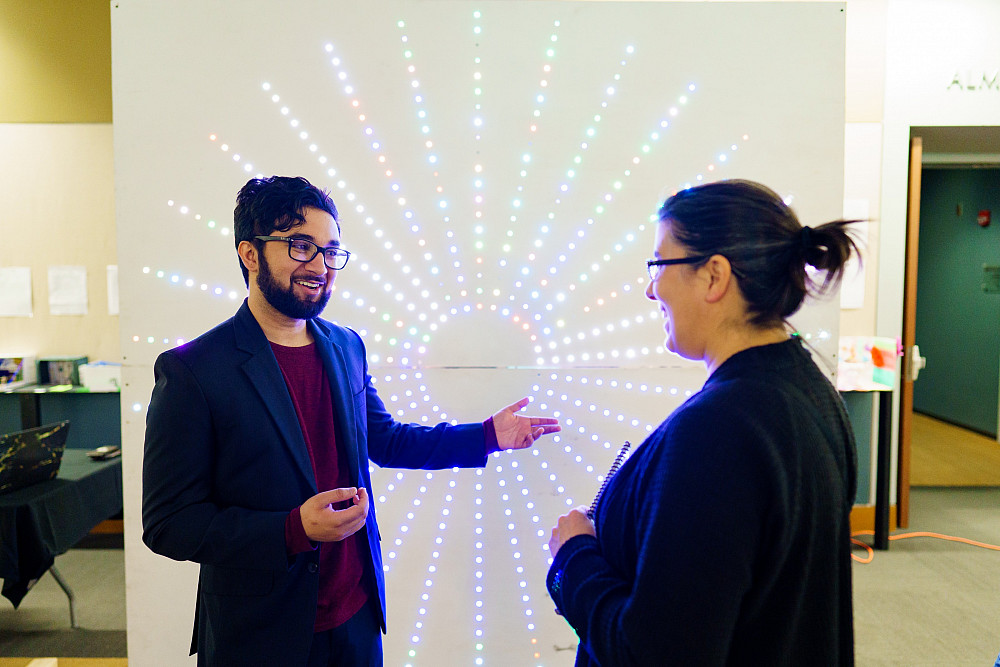News
Baroque Economic Beauty
November 20, 2019
November 20, 2019
Open gallery

When Southwestern hosted its 20th Research and Creative Works Symposium back in April, it was a bright and sunny day. But Ramish Nadeem ’19 and Trevor Stoneburner ’20 were working furiously inside the Alma Thomas Fine Arts Center, adding the final touches to their unique art installation. Stoneburner and his mother, who had arrived from Houston to help, were armed with hot-glue guns, nervously but methodically adjusting the red, white, and blue wires that connected the 600 multicolor LED lights arrayed across two eight-feet-tall wood half boards.
Soon enough, the rainbow of lights were twinkling. Students, faculty, and staff hovered nearby, drawn like moths to the mesmerizing display. But this wasn’t just a work of art intended for visual appeal. Rather, the wall of LEDs represented a complex set of global economic data derived from Nadeem’s work as part of Southwestern’s Financial Analyst Program (FAP).
The origins of the Baroque Economic Beauty project
Stoneburner says that when he first started thinking about the project, he knew he wanted to build an art installation that involved lights. The theater major and business minor has been studying technical theater since high school, and when he’s not in class or constructing projects at Southwestern, he’s an independent contractor who specializes in scenic, lighting, and projection design for theater and entertainment; he’s already freelanced with venues such as the Zach Theatre, the Vortex, and the Long Center in Austin as well as the Heritage Theatre Festival in Charlottesville, Virginia.
His partner wanted to create a project that allowed him to experiment with data visualization. Nadeem had arrived at Southwestern as a biochemistry and economics major, but he dropped the former when he realized that neither medical school nor a graduate program in the natural sciences were paths he wanted to pursue. But he kept on with economics, which, he says, “I sort of fell in love with in AP in high school. I really liked the explanatory powers of these theories, and I thought it was really beautiful to see the basics and core principles stretched over the course of those semesters.” Unlike those of us who struggled to find much inspiration in textbook chapters or discussions about commodities trading or marginal costs, Nadeem clearly appreciates the theories underlying political, international, and commercial economics from a humanistic perspective. That combination of interests in numbers and aesthetics compelled him to enroll in an independent study with Assistant Professor of Mathematics Therese Shelton on nonlinear dynamics and chaos. He reflects, “I would see these beautiful displays of data and this beautiful distillation of really, really complex mathematical principles in a single display in that course, so I wanted to see how I could do that here.”
“I would see these beautiful displays of data and this beautiful distillation of really, really complex mathematical principles in a single display in that course, so I wanted to see how I could do that here.”
The collaborators knew that they wanted to work together, but initially, they weren’t sure what kind of data they wanted to represent. They only had a vague idea of engaging with economic data and thinking about how information is communicated on a global scale. Eventually, though, they decided that they would rely on data sets closer to home: they would use lighting to artfully depict stock-market prices obtained from Nadeem’s work with the FAP, in which students manage part of the University’s endowment through carefully researched and selected investments. Having been involved with the FAP team for a year and a half, Nadeem found the financial data “really interesting and neat,” but he was underwhelmed by the conventional ways that people would encounter those numbers, such as the tickers one might see scrolling in black and white across the bottom of a screen during a newscast or on a stock market website. He wanted to find a way to share his admiration of numbers that those less versed in financial data often see as obscure, bewildering, or even off-putting: “I was trying to think, ‘How can we display all this crazy baroque beauty that goes on here and these complex interactions of market players? How can we display that in a simple, accessible way?’”

Nadeem’s use of the word baroque reveals that he is not just a student of economics; he’s also an art history minor, a course of study he elected because he loved exploring how cultural artifacts make meaning and “articulate an intellectual history of ideas.” Baroque refers to an aesthetic movement that became popular in Western Europe in the 17th and 18th centuries and is characterized by grandeur and opulence—think the Palace of Versailles, the twists and turns of Bernini’s sculptures in Rome, or the dramatic paintings of classical myths and biblical tales by Rembrandt, Rubens, or Caravaggio. When it came to illustrating the ebb and flow of stock prices, Nadeem explains, “That’s exactly what I was thinking about: [rendering] this ornate, grandiose, over-the-top complex interaction of things I see in the market in a harmonic way—this expression of chaotic movements and behaviors in a very clear, neat, and articulated way.”
Learning new tech for a new way of seeing
To accomplish their goals, Nadeem and Stoneburner had to construct a wooden platform and then drill hundreds of holes for the LED lights—a time-consuming and tedious process. But they also had to learn how to code an Arduino Mega unit, a microcontroller device that converts an input into an output, such as translating a light on a sensor or the touch of a button into starting a motor, publishing something online, or, in this case, changing the color and intensity of a small LED lamp. Stoneburner says that “the design of it was the fun, easy part” because he knew that the circular arrangement of the lights “would be a great visualization and would have a nice impact.” However, he admits that although he knows his way around programming a light board, coding this particular board posed a challenge because in theater, “we have a universe of lighting, which is 512 lights, but this board is about five separate theater universes, … so I had to learn this new technical coding and approach to make it work.”
Nadeem echoes the sentiment. “We had no familiarity with coding before this project,” he remarks. “It was not difficult to conceptualize how I wanted to execute it [or] how I wanted to represent the data, [and] setup was a lot easier than I thought it would be. But the actual physical coding of the individual lights was much more difficult. Like, ‘Why can’t I just get this light to do what I want to do?!’”
Despite their troubles, the duo was ultimately satisfied with how their project turned out. “I don’t think I realized how mesmerizing it would be,” Nadeem comments. Stoneburner agrees, opining, “I like the calming-ness of the display that we created because it doesn’t worry you. You see this large drop [in the market] in December, and you know there’s a problem, but it’s still nice to look at; it’s still visually appealing.”
Striking and dynamic, the team’s light board remained on display in the Fine Arts Center throughout this fall, and Stoneburner is especially pleased that it became a gathering spot for students. That was “not its original intention,” he says, “but it seems to be a meeting place because it’s interesting and … people are just drawn to it.” He’s also proud that Baroque Economic Beauty fulfilled the objectives of the King Creativity grant they gratefully received last spring—funding that challenged students to propose and implement truly innovative projects. He and Nadeem were happy to construct something that stood out because it crossed disciplines that represented their commitment to the fine arts, humanities, and social sciences. “We wanted to lean more into the creative aspect of it,” Stoneburner explains. “Ours was creative in an artful way, but it was also creative [in that it was] interdisciplinary.”

Bright futures
The next phase of the Baroque Economic Beauty installation remains to be seen. Nadeem hopes to create an even more dynamic and interactive display, and Stoneburner would like to enlarge the scale of the project and exhibit it in a more public venue. But for now, they’re both grateful for the opportunity to carry out their vision.
“It was really great to have the University’s support to do something like this,” says Stoneburner, who is completing his final year at the University. “King Creativity is a great thing… . I consider myself a designer within entertainment, but I want to get more into art installation, creating my own original work as an artist, and with the University’s funds, I can experiment. I learned what I can do in future projects, and now I have others ideas of what I want to do with art installations that I can build.”
Nadeem, who graduated in May, says he could see himself applying his combined skillsets in art history and economics in a field like urban planning. Otherwise, he might eventually seek a graduate degree in art history or media studies because, as Baroque Economic Beauty demonstrates, he’s interested in our “changing world, changing media interactions with the world, and the ways in which our interactions with the world are mediated.”
“That’s a long way to say, ‘I don’t know,’” Stoneburner teases.
“I have no idea which way to go,” Nadeem confirms with a laugh.
But if their luminous installation says anything, it certainly foretells that these two creators have nothing to worry about.

















